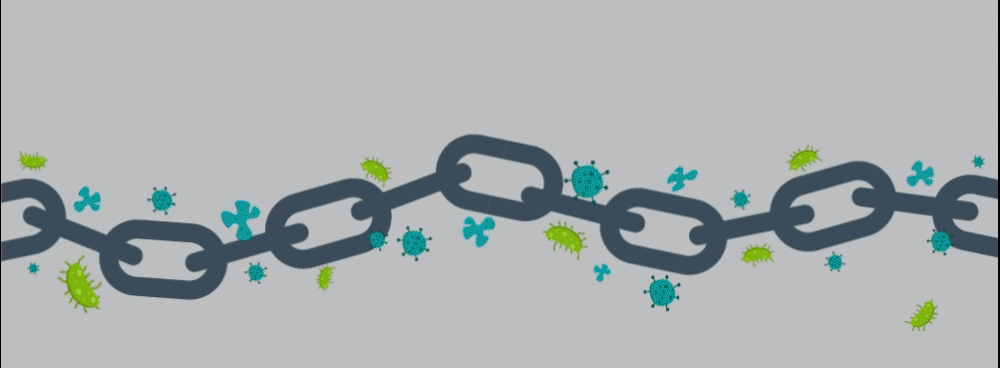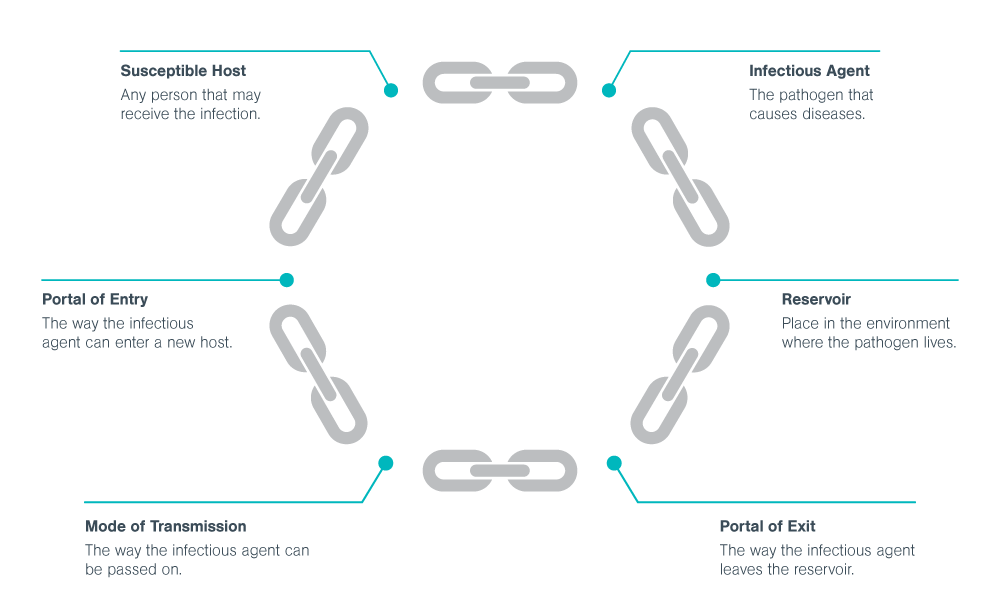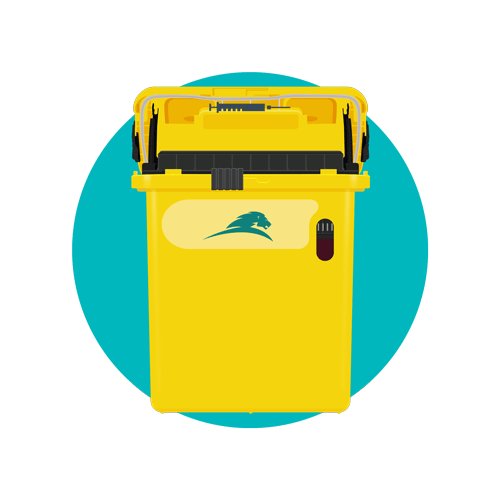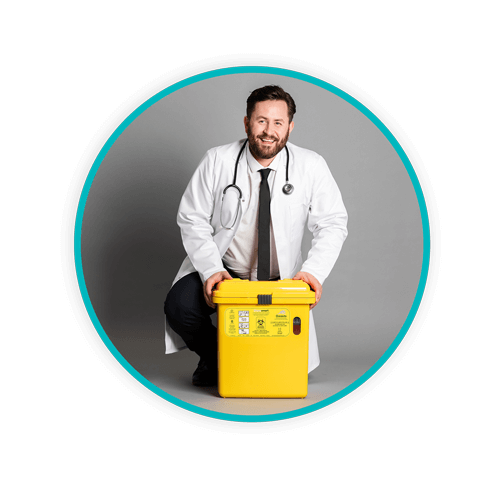How Do Reusable Containers Break the Chain of Infection?

Reusable waste containers have many advantages for the environment, as well as for healthcare facilities and their workers. But you may have concerns that such containers could increase the risk of infection within your organisation. A South African study found little to no increased risk of infection while using reusable waste containers. But there’s so much more to the story.
You may be surprised to learn that reusable containers can actually help prevent infection by breaking the chain of infection. With statistics showing that 1 in 12 patients in healthcare facilities in Canada acquires an infection unrelated to their condition and incidence of some antimicrobial resistant pathogens still on the rise, now more than ever, leaders need to be as proactive as possible when it comes to risk factors. Read on to learn about the six links in the chain of infection and how reusable containers can help to reduce the occurrence of infection within healthcare facilities.
TOPICS WE WILL COVER:
1 / Links in the Chain of Infection
2 / Breaking the Chain of Infection with Reusable Containers
3 / How Reusable Containers Help Break the Chain of Infection
4 / Choosing Waste Containers that Help Reduce the Risk of Healthcare-Associated Infection
Links in the Chain of Infection
There are six links in the chain of infection that are necessary to pass a disease from one individual to another. All of these links must be connected for an infection to occur. If even one of these links is broken, the infection will not be transmitted. Here are the links in the chain of infection:
- Pathogen: Pathogens (or infectious agents) are microorganisms that cause disease. They include fungi, parasites, bacteria, and viruses.
- Reservoir: A reservoir is the source of a pathogen. It is the place where they live and reproduce. It could be a person, water, blood, or food, among others.
- Portal of Exit: A pathogen must have a way to exit the reservoir in order to infect a person. The means of exit could be saliva, blood, or other bodily fluids.
- Mode of Transmission: Pathogens can be transmitted in many ways, depending on the type of pathogen – ingested, injected, inhaled, or absorbed (through contact).
- Portal of entry: In order for a pathogen to be transmitted, there must be an opening for the pathogen to enter the body. Common portals of entry include broken skin and mucus membranes (eyes, nose, mouth, lungs).
-
Susceptible Host: The last link in the chain of infection is a susceptible host. If the pathogen enters the host, and the individual does not have sufficient immunity to fight off the pathogen, the infection will be transmitted.

Breaking the Chain of Infection with Reusable Containers
There are several proven ways to break the chain of transmission that are considered best practice in healthcare today: hand hygiene, PPE (masks, gloves, gowns, eye protection), safe handling of body fluids and sharps, and immunization. But did you know that Daniels’ reusable containers are also proven to break the chain of infection?
How Reusable Waste Containers Help Break the Chain of Infection
Reduce Disposal-Related Sharps Injuries 
Due to the nature of their work, healthcare workers are susceptible to sharps injuries. Each sharps injury creates a portal of entry for pathogens on the sharp to enter the body. However, using Daniels Sharpsmart reusable containers can help prevent disposal-related sharps injuries.
Daniels' reusable containers are puncture-proof, meaning there is no possibility of a sharp puncturing the container and creating a wound through which pathogens could enter the body. Sharpsmart containers are designed with a wide aperture and a hand access-restricting safety tray. The wide aperture allows for the safe one-handed disposal of sharps of various sizes, preventing larger sharps from becoming lodged in the opening and presenting an injury hazard. The safety tray prevents hand access to the container contents, which in turn prevents sharps injuries related to contact with needles and other sharps.
The safety tray also prevents disposal beyond the safe fill level. When the fill level has been reached, the tray remains in an upright position and blocks the disposal of more sharps into the container. This eliminates the risk of sharps injury due to an overflowing sharps container.
The features of Daniels’ sharps containers are designed to break the chain of infection by reducing disposal-related sharps injuries, which create a portal of entry for pathogens.
Added Convenience
No matter how safe a container may be, it’s not going to make a beneficial impact on the chain of infection if workers don't use it. Staff is always short on time and workers are not likely to use waste containers unless they are easily accessible at the time of disposal. That’s why Daniels created reusable medical waste containers that are easy to place and move. Numerous mounting options allow them to be placed where they are needed most, whether at the bedside, in a med room, or on a mobile cart. Readily accessible sharps containers reduce the time spent handling sharps, which in turn reduces the probability of receiving a sharps injury.
Leak Prevention
Some healthcare facilities still use the bag and box method for medical waste disposal, but this method carries with it a risk of leaks. Such leaks put workers and patients at a greater risk of infection. However, Daniels' reusable containers are equipped with leak-proof seals, meaning that you can be confident that no contaminated bodily fluids will leak out of these containers.
Not a Source of Pathogen Transmission 
One of the most common pathogens that infect patients within hospital walls is Clostridium difficile. These bacteria are most commonly spread in a patient environment where surfaces are frequently touched and become contaminated. Sharpsmart containers help to reduce this risk. Their hands-free operation prevents contamination, because they do not need to be touched during sharp disposal. Wall-mounted sharps containers are kept away from the patient, reducing the probability of direct contact. Sharpsmart containers can break the chain of infection by preventing healthcare workers from becoming infected while disposing of medical waste.
Preventing Cross-Contamination
Daniels’ reusable containers are washed and sanitized in an 8-stage decontamination and QA process. Once cleaned, Sharpsmart containers are not stored or transported with any full containers, preventing cross-contamination before arriving at a healthcare facility.
Choosing Waste Containers That Help Reduce the Risk of Healthcare-Associated Infection
Daniels understands how important it is for healthcare facilities to break the chain of infection. Our containers boast hands-free operation, are easy to move and place, leakproof, and puncture-proof, making them a valuable part of your infection prevention protocols. Making the switch to intelligently-designed reusable waste containers is a practical step that’s straightforward and easy to implement. Learn more about how Daniels has helped other Canadian healthcare facilities and reach out to secure a consultation for your location.
